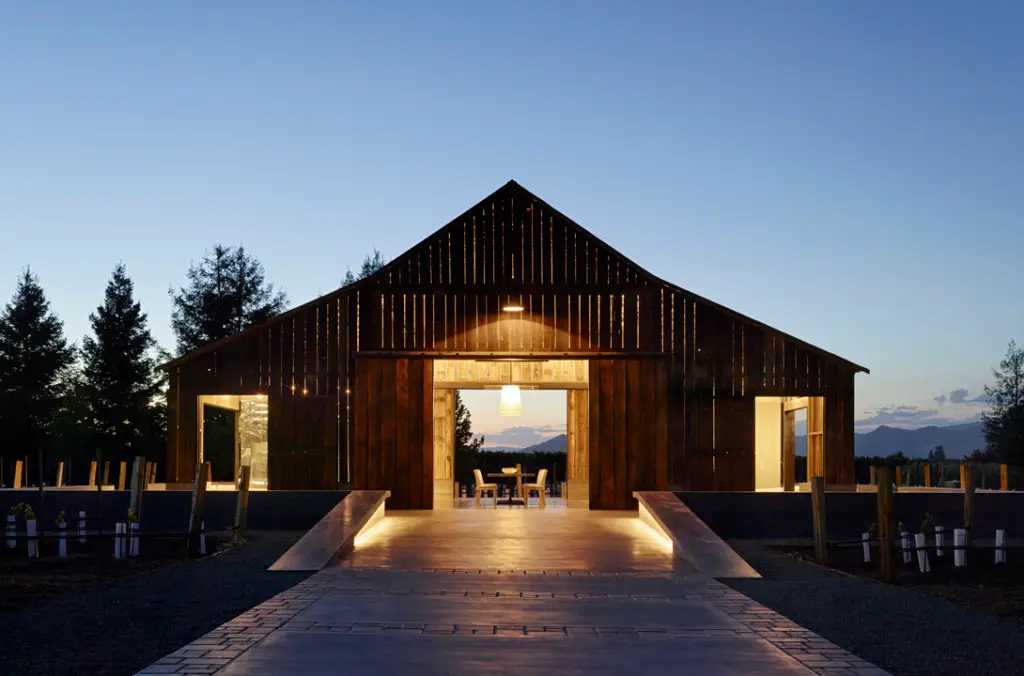With smoked mirrors, architect William Duff transformed a modest barn in Napa into a luminous sculpture.
A WELL-DESIGNED BUILDING can well be viewed as art, and one San Francisco architect has found a way to combine art and architecture to bring out the best of both. “I like to explore the inherent qualities of carefully edited materials for a more holistic architecture,” William Duff says.
In doing so, Duff, also the board chair at Sonoma’s di Rosa art gallery and grounds, has become a proponent of unusual residential and commercial modern projects that close the gap between design and art.
Recently, he restored what he calls a “quintessential gabled barn,” a century old, in the Napa Valley for noted contemporary art collectors and philanthropists Cindy and Howard Rachofsky. Their 10,000-square-foot Richard Meier–designed mansion in Dallas is where much of their lauded art collection that has been promised to the Dallas Art Museum resides year round, but the Rachofskys like to spend summers (and reportedly New Year’s Eve) out west, where the weather is clement near the coast.
For their seven-acre California outpost, amid a vineyard and a large organic vegetable garden dotted with some of their burgeoning collection, including sculpture by the likes of British sculptor Richard Long and Korean designer Lee Hun Chung, they asked for a modest dining pavilion, within sight of the main house but closer to the vines, where they could entertain guests.
Requiring only a minimalist aesthetic and the flexibility to use the party venue for large or small gatherings, they opted for a slatted wood barn that could be thrown open or kept closed depending on the crowd size and the weather.
Duff relocated the historic archetypal building to its current site, completely restored it and inserted two rectangular, steelframed, mirror-clad pavilions inside. One is a state-of-the-art catering kitchen and the other an exercise gym.
The barn is now literally and figuratively a “reflector of its surroundings,” the architect says. “The guiding principle for this project was light.”
The mirrored pavilions are spaced far enough apart to make room between them for a very large dining table by New York’s BDDW. Oversize hollow fiberglass lanterns by Alan Knight hover overhead, creating a focal point for the mostly muted palette of grays inside, including bleached rift-sawn oak for the service bar (hidden behind sliding doors when not in use) and new stained wood rafters that were added in conjunction with the steel structure to shore up the metal roof.
In that incandescent setting, and thanks to the opposing reflective walls, even an intimate gathering looks like a sizable, colorful party, and diners can enjoy ricocheted views of gardens and vineyards in every direction.
The gym, clad in two-way mirrors (transparent from the darkened side), is as reflective as its twin pavilion, yet allows users inside it to look out at views during the day; at night it becomes a kind of see-through lantern when lighted inside.
The barn, faithful to its original design, with gaps between the siding that once allowed light and air in for livestock and drying hay, now has a new board-formed concrete foundation, to elevate it above the surrounding vines. Light streams in through the structure’s wooden slats, forming expressionistic patterns on the new dark-stained polished floors, and when the barn doors are rolled back, the gleaming smoked mirrors reflect the view.
In an effortlessly sculptural way, this reimagined barn engages the historic, ecological and formal character of its surroundings while poetically integrating patterns, light and views. “Given the constraints an architect needs to contend with, it’s challenging to be artful with buildings,” Duff says, but this one “is as close to art as any building I’ve ever done.”

